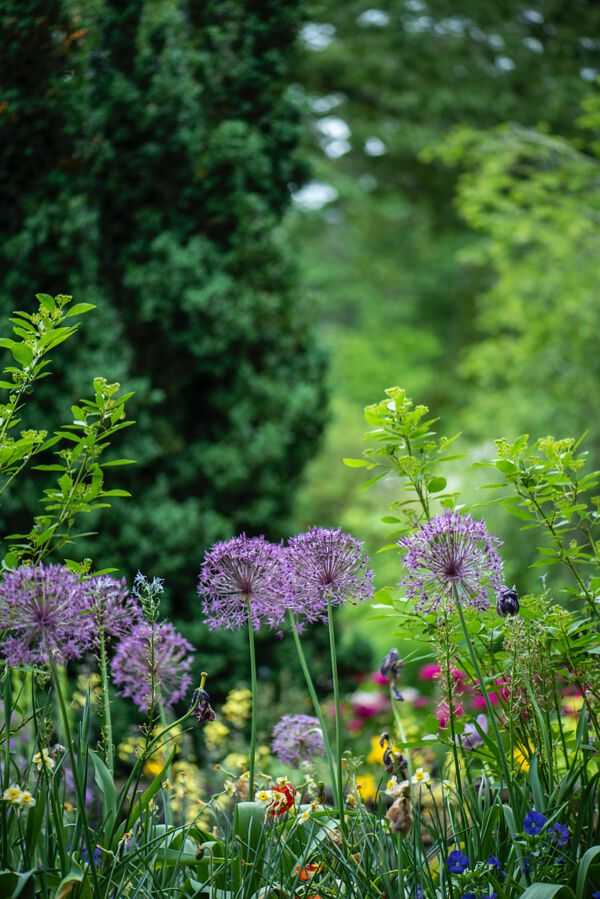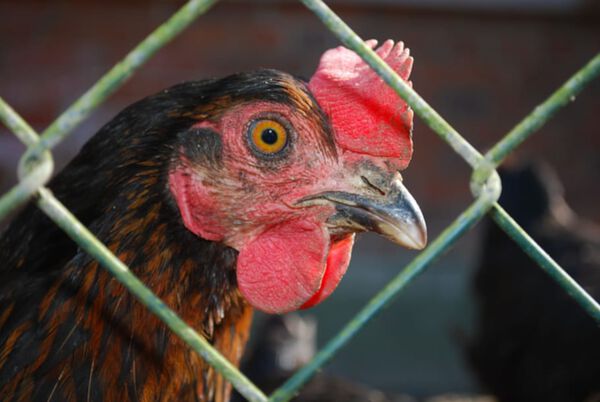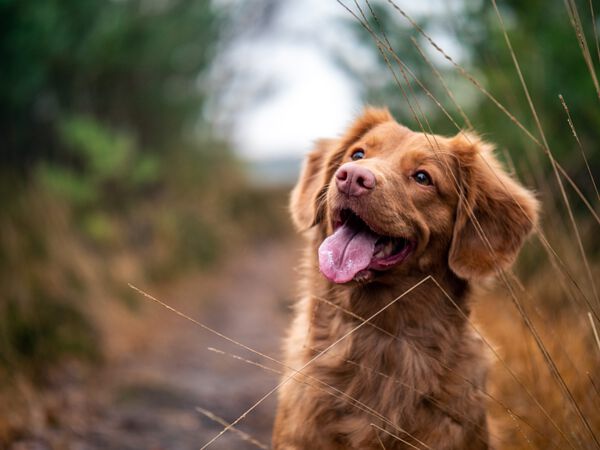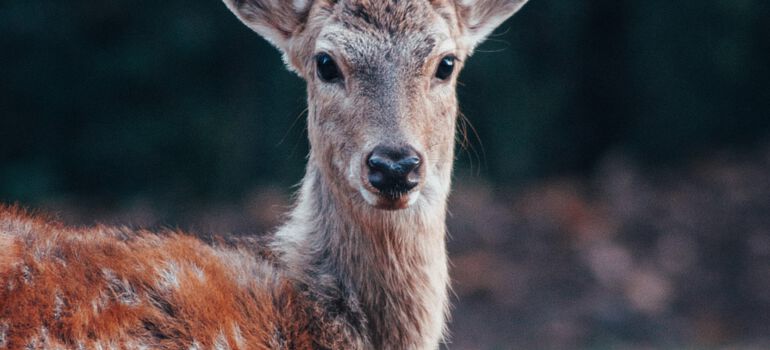There are a lot of recommendations out there about how to keep deer out of the garden, but I find that many of them don’t really work. Or they work for a while before the deer wise up. These are the methods that I found work and work for good.
What are the best ways to keep deer out of the garden?
- Invisible fishing line fence
- Plant a barrier of lavender or strong smelling plants
- Double layer fence, spaced about 5 feet apart
- Guard dogs, goose, or other animals
Follow along as I go through the pros and cons of each of these methods. As well as cover tips to make them work well in your particular situation.
Keeping Out Deer with Fishing Line
The fishing line method is one of the most popular, quickest, and cheapest methods for keeping deer out of the garden. The basic principal is that fishing line is basically invisible to deer until they get very close to it. By hanging it around the garden it serves to scare the deer away, while not being visible enough to allow them to jump over it like they do other fences.
Pros of the Fishing Line Deer Fence
- Cheap (<$20 in many cases)
- Quick to set up and works immediately
Cons of the Fishing Line Deer Fence
- Prone to breakage, needs occasional repair
- May get in your way
- Not very nice look at
Setting up a Fishing Line Deer Fence
Materials You will need enough fishing line to surround your garden and enough stakes to support the line every 4–5 feet.
Install by placing stakes spaced about 5 feet apart around the parameter of the garden, so that they are about 3 feet above the ground. Keep them an arms length away from any potentially edible plants, otherwise the deer may be able to reach over and nibble without encountering the fence.
String the fishing line, 10–15 pound test, all the way around the garden about 3’ above the ground. Be wary of any locations where a falling branch or tall grasses pushed over might push the fishing line down, breaking the fence.
Tips
- Place bright or reflective objects every so often on the fishing line to avoid accidentally encountering the fence yourself.
- Tie a rock on one end of the fishing line. This can hung over the last stake instead of tying it, and functions as a simple gate

Protecting Your Garden from Deer with Lavender or Strong Smelling Plants
While fishing line might be a quick and easy solution, on step up the ladder of better design is to design a “fence” that can be used for many purposes at once. Instead of a fixed fence that needs repair, planting a border of useful yet deer repelling plants around the garden is a wonderful alternative or additional protection to more traditional fence designs.
The there behind this method is that many plants with strong smells make it difficult for deer to detect predators near by. Deer have a very acute sense of smell which they use constantly to sense dangerous animals in the area. Being in an area with strong smells that hinder their ability to sense danger around them makes deer uneasy, and they will likely go a different way if they encounter such a situation.
While there are many deer repellent sprays available, growing your own repellent right in you garden is much more fun and economical than remember to spray a store bought concoction every so often.
Pros
- Little or no maintenance required
- Inexpensive (just a few packets of seeds or starts)
- Provides useful plants for the garden
- Beautiful
Cons
- Takes time for the plants to grow
- May not work all year long
Plants that Protect Your Garden from Deer
Many herbs or fragrant plants are perfect borders for the garden. While there are many many options, here are a few of my favorite plants to use as a deer guard, since they are attractive, effective, and have secondary purposes besides blockading the deer invaders.
Mint
A classic garden plant with strong smells. Grows very easily in many conditions, almost too easily in fact. A soothing fragrance for humans, but not so inviting to the deer. Useful as a cooling culinary herb or as a component in fresh or dried mint teas.
Dill
Tall and spindly herb essential for dill pickles and great in a wide variety of fermented foods. Staple culinary herb of the Mediterranean and middle east.

Bee Balm
Bee balm is a gorgeous flowering plant that attracts beneficial animals such as bees, hummingbirds, and butterflies. Meanwhile, it repels deer. Leaves of bee balm can be eaten as a green, or dried for use in herbal teas.
Chives
Strong tasting and smelling. Great on omelets and baked potatoes. Also great for keeping the deer away. Chives are easy to grow and, once established, or self sewing making continual maintenance almost automatic.
Cosmos
Up to 5 feet tall, these colorful plants can handle a wide range of soils and are fine in dry conditions, meaning a few missed days of irrigation won’t kill off your deer fence. Fast growing.
Garlic
Already found in many gardens, a plant that as innumerable culinary uses and requires little or no maintenance to grow. Plant garlic around the parameter of your garden to help keep the hungry deer at bey.
Oleander
A tall evergreen shrub that is poisonous and thus unattractive to deer. Can grow up to 20 feet tall which makes this an effective year round deterrent. Beautiful flowers make oleander an attractive ornamental.
Rosemary
A classic kitchen herb that is all the better for being picked fresh from the garden. Fragrant and woody with needle like leaves that can reach up to 3 feet tall and are evergreen in some climates.
Russian Sage
A hardy perennial that is known to grow up to five feet tall. Sage is best known as a particularly potent poultry seasoning and is great for cooking both fresh and dried.
Thyme
Another hardy and fragrant culinary herb. Easy to grow yet and great to have around both fresh and dried. Thyme deters deer from entering the garden.
Hyssop
A traditional medicinal plant. Used historically to tread sore throats, colds, hoarseness, and as an expectorant. Also a natural bug repellent which can be strategically placed to reduce overwhelming bug presence around the garden. Hyssop is good for keeping deer out of your garden.
Tips
- Plant a wide variety of deer repellent plants, as deer can become acclimated to over use of a single plant
- Incorporate border plants not only because they protect from deer, but also because you enjoy them or they have beneficial use in the home.
Double Layer Anti-Deer Fencing
One good fencing method for keeping deer out of garden while serving a secondary purpose is the double layer fence or “chicken moat” method preferred by permaculturists and non-permaculturists alike.
In most cases a very tall fence, 8’ – 12’ tall, would be necessary to keep deer from jumping in the garden. This depends on the slope of the land in that area and how much running room the deer have to approach the fence. Preferably, tall deer fencing should be solid, so the deer cannot see on the other side, which makes them less likely to jump in to the unknown. All of this can be quite expensive, not to mention blocks sight lines and reduces available sun i the garden.
On the other hand, double layer fencing can be shorter if you choose, 3’ – 5’ tall, and can be a more inexpensive wire fence or picket style fence. The key here is to build two lines of fencing, one inside the other, about 5 feet apart. Deer don’t like being in confined spaces, and will not jump between the two fences, and are not able to jump far enough to hop directly in to the garden center.
Permaculturists love this method because it leaves a safe space for chickens to travel around the garden, allowing them to eat pesky bugs and slugs while preventing them from destroying the garden plants themselves. This corridor also makes a great place to plants to help feed the chickens like amaranth, sunflowers, or some of the taller variety of deer repellent plants listed above.
Pros of the Double Layer Anti-Deer (Chicken Moat) Fence
- Cheaper than a single tall fence in most cases
- Provides space for chickens and other foraging domestic animals
- Allows more Sun to enter the garden
- Very permanent and needs little maintenance
Cons of the Double Layer Anti-Deer (Chicken Moat) Fence
- Require installing two fences
- Takes up more ground space than other methods or a single fence
- The most costly method on this list

How to Build a Double Layer (Chicken Moat) Fence
Bailing a chicken moat is not too difficult. I recommend planning your outer fence first. Layout the corners first, then choose the spot for in between posts about every 10’ feet or so apart (for chicken wire). One you know where the posts will go, drive them or dig them in to the ground, being sure to keep them plumb. Be sure to run diagonal wires or cross braces in the corners to keep the straight. Then, wire up or nail your fencing starting at the gate, and all the way around to the other end.
The inner fence is easy to lay out, just measure the width of your moat inside of each pole. Place one inner pole that corresponds to each pole of the outer fence. Wire and wrap the same way.
Some chicken moat building guides recommend you wire the inner and outer fences together for added support. To my mind this is not necessary and makes it too difficult to work between the two fences.
Tips
- Take care planning your fence placement. Nothings worse than getting half way through build a fence only to realize you need to move part of it.
- Build strong gates, and be sure there is room for both of them to swing open without hitting each other.
- If you size the gates exactly the same width as the distance between the fences, you can open both in to the moat area, and close of the chicken area while opening up access to the garden. Pretty handy during heavy gardening season in spring and fall.

Keeping Chickens out of the Garden with Guard Dogs, Geese, or Other Animals
Probably the most traditional form of anti-chicken technology. A vocal dog or territorial goose will do a lot to scare deer away from the garden. Even the smell of the animal in the area may deter deer from going that way, depending on their experience with dogs in that area.
The biggest problem with guard dogs is that for most people dogs become pets, and don’t spend enough time out in the garden to make deer wary of the presence. Deer are most active in the twilight hours of dawn and dusk, so if your animals don’t spend nights out by the garden, there is a good chance the deer’s destructive nighttime raids will go unchallenged.
Geese are a less common although quite effective guard animal that can be put to work defending the garden. Historically, the ancient Romans used geese to guard their military camps at night, so we know that they can be trusted to raise the alarm when necessary. And, unlike dogs, there is little impulse to play with the geese or keep them inside.
If you already have a flock of chickens, then adding a single goose is easy to do, as it will integrate with the flock and act like a chicken. However, if there are multiple geese, they will not necessarily stick with the flock of chickens, but may go off on their own.
Pros of Keeping Guard Dogs / Animals
- May already be necessary to protect chickens or domestic animals
- Probably the most fun way to protect against deer
- Geese can be an extra source of meat and eggs on the homestead
Cons of Keeping Guard Dogs / Animals
- Must be feed and cared for daily
- Dogs require training
- Can be aggressive towards humans
How to Select and Train a Guard Dog to Protect Against Deer
Choose a good breed or mix that is natural content with the guard dog role and the outdoors, such as Shepard’s or mastiffs, although there are many breeds that have been breed to preform this role. Guard dogs are best acclimated to living out doors from a young age, while being trained to respect any livestock you might have yet be aggressive towards deer and other intruders.
It is generally best not to keep the dog directly in the garden, but make sure it spends most of it’s time in that area.
How to Select and Train a Guard Goose to Protect Against Deer
While any variety of domestic goose can be used to guard you garden, Chinese Geese and African Geese are the loudest and most intimidating species. Which makes them a bit better at guarding your garden or flock of hens from deer.
Geese eat grass, and can be kept in similar conditions as chickens, although they need a deeper trough of water so they can keep their back clean.
If you already have a flock of hens, adding a single goose to the mix will mean that the goose will bond to the chickens and protect them as well. Although you have the option of keeping a flock of geese as well. Like chickens, geese must be kept out of the garden, but near enough to deter deer from entering. Putting them in the “chicken moat” as described above is a good way to double your protection while keeping your geese safe and in the right area to protect against deer.
Tips
- Don’t get too friendly you guard animals. As working dogs or geese, they shouldn’t be too comfortable with strangers which can happen if they get too attached to their humans
- Chicken moats are a great place to keep guard animals both near the garden enough to protect it from deer, while protecting the garden from the guard dog / goose.
Related Questions
Does fishing line keep deer out of the garden?
Yes. When hung around the garden about 3 feet above the ground it can serve to deter deer from entering. This invisible deer fence startles deer when they come in to contact with it, and can work better than a short fence, which they just jump over.
What plants repel deer?
Plants with strong smell work very well at repelling deer including herbs, like dill and thyme, fragrant plants garlic and chives, as well flowers like bee balm and cosmos. Deer prefer to stay away from strong smells, because they make it harder to smell incoming predators.


